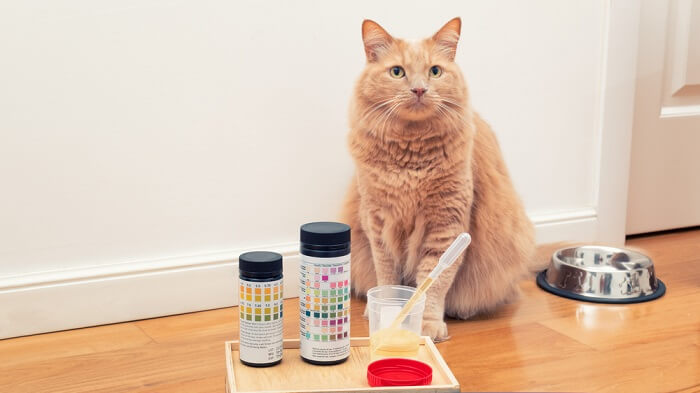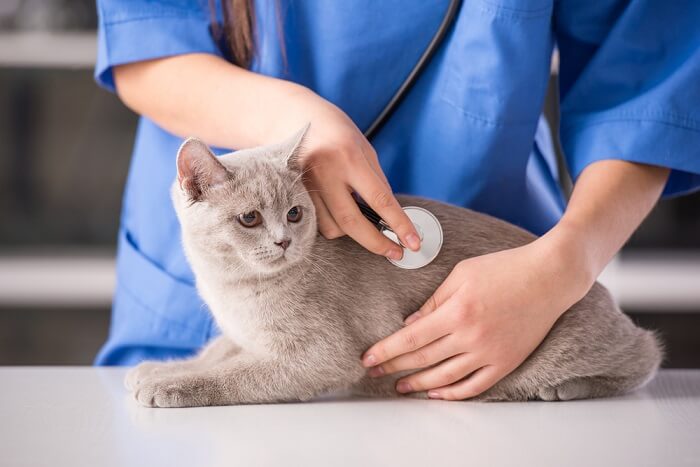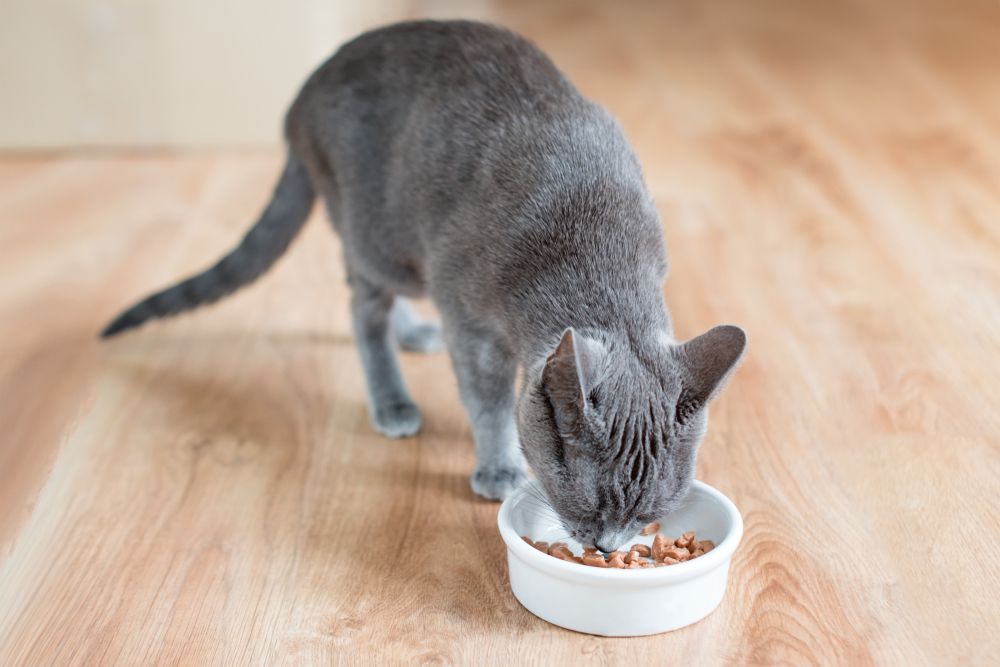
Epakitin is a powdered phosphorus binding agent manufactured by Vetoquinol that is used as a supportive nutritional supplement for cats with chronic kidney disease (CKD). In this article, you’ll learn what Epakitin is, how and when it’s used, and potential side effects to monitor for.
Epakitin for Cats Overview

About Epakitin for Cats
Epakitin is a phosphorus binding agent. In pets with chronic kidney disease, kidney function has been found to be greatly impaired by higher dietary phosphorus intake. In more recent years, limiting dietary phosphorus intake in cats has been targeted as one of the most important components of managing CKD in cats to provide kidney support.
Restricting dietary protein has also traditionally been a component of managing renal disease as well, as this helps to reduce workload on the kidneys trying to excrete the waste products of dietary protein. However, restricting protein too much will lead to loss of muscle mass.
Dietary phosphorus and protein are interrelated. Commercially prepared diets formulated for cats with kidney disease are restricted in both and these diets often help to improve bloodwork values in cats with CKD.
However, as many pet owners with kidney disease cats know, not every kitty will eat a prescription renal diet. Many cats with kidney disease can be very picky about food and frequent diet changes can be common to keep a kitty’s interest.
Many veterinarians thus strive to strike a balance between ensuring the right nutrition components for kidney disease, but also making sure that a cat with CKD is taking in the right amount of calories.
Sometimes, this means allowing a cat to eat what he or she is most willing to eat, even if that means it’s not a diet formulated for kidney disease.
This is where a phosphate binder comes into play. By mixing a phosphorus binding agent in with a kitty’s diet, regardless of what that diet is, dietary phosphorus will be bound, with most of it excreted in the stool, sparing the kidneys further damage and slowing down progression of chronic kidney disease.
What Is Epakitin Used for in Cats?

Talk to your veterinarian before starting any new supplement, including Epakitin.
Epakitin contains two main ingredients, calcium carbonate and chitosan. Calcium carbonate binds to phosphorus, forming calcium phosphate, which is then eliminated in the feces.
Chitosan is a natural polysaccharide, or complex carbohydrate, derived from the shells of shrimp and crab. This ingredient also naturally binds phosphorus from the diet.
Cats with kidney disease commonly have bloodwork elevations in two waste products called blood urea nitrogen and creatinine. Actual bloodwork phosphorus levels are not always truly elevated.
But even if bloodwork phosphorus levels are not high, use of a phosphorus binding agent still spares the kidneys from damage and improvements can be seen in creatinine and urea levels.
Supplementing with calcium can also of course, increase calcium levels. The body tightly regulates calcium and phosphorus, keeping them in balance. In some cats with kidney disease, calcium levels may be low. In these cases, using a supplement containing calcium like Epakitin, can help to manage calcium levels.
Side Effects of Epakitin for Cats
In humans, nausea and constipation have been reported side effects when using a calcium carbonate product. However, in pets, no side effects of this kind have been reported. Epakitin is generally very well tolerated.
The main concern that requires monitoring is related to phosphorus and calcium levels. Supplementing with any calcium supplement can lead to elevated calcium levels, which can lead to serious complications. While this appears to be uncommon, monitoring is still a very important component of management.
The International Renal Interest Society (IRIS), an organization founded to further study and establish standards of care for pets with kidney disease, recommends bloodwork checks every four to six weeks initially for pets with kidney disease after starting a phosphorus binder. If levels are found stable, rechecking bloodwork every three months is then recommended.
Also Read: Cat Bloodwork (Different Types of Tests, Health Conditions And Costs)
There are several types of medications that need to be considered carefully when used in conjunction with a phosphorus binder/calcium supplement, as the effectiveness of some medications may be reduced. A couple others may increase calcium levels. Always make sure to discuss all medications or supplements your cat is taking when considering use of Epakitin or any similar product.
Overdoses of Epakitin are uncommon. However, in theory an overdose of a calcium supplement could lead to elevated calcium levels in the body. If you are concerned that this may have happened, make sure to contact your veterinarian, the ASPCA Animal Poison Control Center (1-888-426-4435), or Pet Poison Helpline (1-855-764-7661) for further advice.
Epakitin for Cats Dosage

Epakitin is formulated as a powder and is mixed into your cat’s food.
According to the label, one level spoonful, equivalent to 1 gram of powder, per 11 pounds of body weight should be mixed with pet food in the morning and in the evening. This may be the appropriate dose for most cats. The powder may be most successfully given when mixed with wet food. A measuring spoon is provided with the product.
For cats who weigh much less or much more than 11 pounds, consulting with a vet would be needed to determine what dosage would be best.
The most important aspect of using a phosphorus binder is that it must be given at the time of a meal to be effective, as it is primarily binding phosphorus introduced to the body from the diet.
If a phosphorus binder is not given at the time of a meal, it is not going to be effective.
Conclusion
Epakitin can be an important component of managing chronic kidney disease for some cats. Not all cats with CKD may need to use Epakitin, so it is very important to discuss using this product with your veterinarian before starting it.
Frequently Asked Questions
What is Epakitin used for in cats?
Epakitin is used as a phosphate binder to help reduce dietary phosphorus intake in cats with chronic kidney disease. Higher levels of dietary phosphorus are associated with worsening kidney damage and reducing levels can help support the kidneys and improve management for some cats with chronic kidney disease.
Epakitin may also be used to support calcium levels in some cats with low levels of calcium in the body, which is called hypocalcemia. Although less commonly seen in general, kidney disease is the most common cause of low calcium levels in cats.
Do you need a prescription for Epakitin?
Epakitin is classified as a nutraceutical or supplement, and so a prescription is not required to purchase it. However, this does not mean that this product should be used without consulting a veterinarian first.
Any calcium supplement could theoretically lead to increased calcium levels in the body, which is called hypercalcemia. While uncommon, hypercalcemia can cause serious health concerns. Not all cats with chronic kidney disease may need a phosphorus binder/calcium supplement, so always discuss this supplement with your vet before using it.
What is Epakitin made of?
Epakitin is a powder supplement composed of the two ingredients calcium carbonate and chitosan. Calcium carbonate is a common form of calcium used as a calcium supplement and/or phosphate binding agent. Chitosan is a complex carbohydrate derived from shellfish and crab that also functions as a dietary phosphorus binding agent.
What is a phosphorus binder for cats?
A phosphorus binder is used to bind up, and essentially deactivate, phosphorus that is introduced to the body through the diet. In cats with chronic kidney disease, dietary phosphorus has been associated with kidney damage and worsening disease.
Prescription diets formulated for cats are formulated with low levels of phosphorus, which may be sufficient in most cats to keep dietary phosphorus levels low. However, if this is either not sufficient, or if a cat is eating a diet that is not restricted in phosphorus, a binding agent like Epakitin may be needed to support the kidneys and help with management of kidney disease.








My Shiloh kitty is a 7 year old neutered male orange tabby who has had now 3 uti’s where surgery to unblock him has been done ..they want him to eat the cd science diet but he doesn’t like it and also it’s way too expensive…I do feed him the iams urinary tract dry cat food and give him also like a half can of canned cat food s day along with lickable treats which he loves and I also add water to the lickable treats and his canned food also! Would this product help him to not get the UTI obstruction again?
Hi Rhonda, I’m sorry to hear your kitty has had these recurrent urinary obstructions. Just to clarify, they are not caused by a urinary tract infection, but by a combination of urinary tract inflammation, mucus and mineral grit. Underlying stressors are thought to be the main contributor in many cats.
The prescription diets for this purpose work in one way by keeping the urine pH as neutral as possible. We know that some mineral grit and bladder stones form in alkaline/basic pH while others form in acidic pH. The prescription diets are the only ones guaranteed to be formulated to do this. Some variations are also formulated to help with weight loss and stress.
There are brands other than Hill’s c/d that you could try. My own cats preferred Purina UR and there is also Royal Canin SO.
If prescription diets cannot be utilized, many vets will advise providing as much a proportion of canned food as possible to increase the water intake the cat has, as this is thought to help reduce the risk of mineral grit formation in the urine.
With any non-prescription urinary health diet, there are no specific labeling requirements companies are required to meet, so they can have variable ingredients and formulations, making it difficult to say that one of them will for sure be helpful.